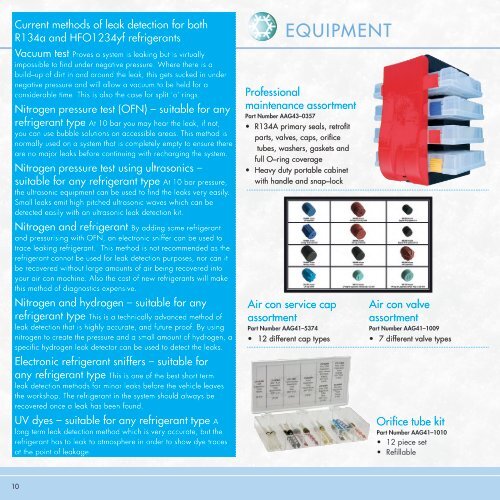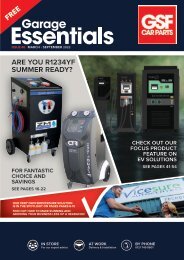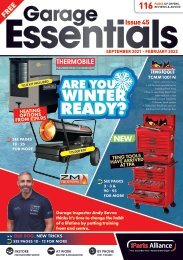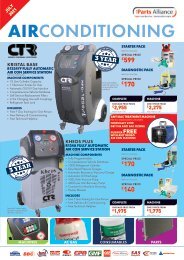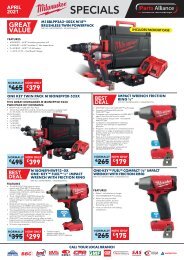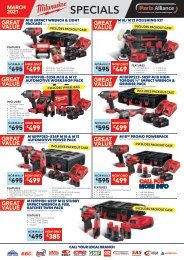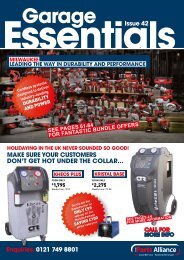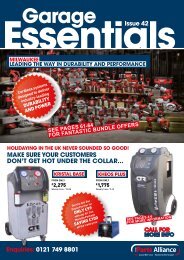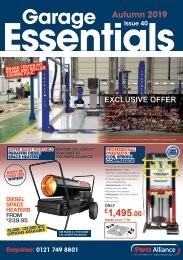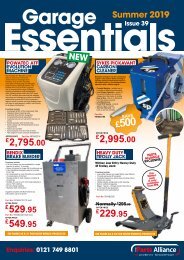IcestationBrochure
Create successful ePaper yourself
Turn your PDF publications into a flip-book with our unique Google optimized e-Paper software.
Current methods of leak detection for both<br />
R134a and HFO1234yf refrigerants<br />
Vacuum test Proves a system is leaking but is virtually<br />
impossible to find under negative pressure. Where there is a<br />
build–up of dirt in and around the leak, this gets sucked in under<br />
negative pressure and will allow a vacuum to be held for a<br />
considerable time. This is also the case for split ‘o’ rings.<br />
Nitrogen pressure test (OFN) – suitable for any<br />
refrigerant type At 10 bar you may hear the leak, if not,<br />
you can use bubble solutions on accessible areas. This method is<br />
normally used on a system that is completely empty to ensure there<br />
are no major leaks before continuing with recharging the system.<br />
Nitrogen pressure test using ultrasonics –<br />
suitable for any refrigerant type At 10 bar pressure,<br />
the ultrasonic equipment can be used to find the leaks very easily.<br />
Small leaks emit high pitched ultrasonic waves which can be<br />
detected easily with an ultrasonic leak detection kit.<br />
EQUIPMENT<br />
Professional<br />
maintenance assortment<br />
Part Number AAG43–0357<br />
• R134A primary seals, retrofit<br />
parts, valves, caps, orifice<br />
tubes, washers, gaskets and<br />
full O–ring coverage<br />
• Heavy duty portable cabinet<br />
with handle and snap–lock<br />
Nitrogen and refrigerant By adding some refrigerant<br />
and pressurising with OFN, an electronic sniffer can be used to<br />
trace leaking refrigerant. This method is not recommended as the<br />
refrigerant cannot be used for leak detection purposes, nor can it<br />
be recovered without large amounts of air being recovered into<br />
your air con machine. Also the cost of new refrigerants will make<br />
this method of diagnostics expensive.<br />
Nitrogen and hydrogen – suitable for any<br />
refrigerant type This is a technically advanced method of<br />
leak detection that is highly accurate, and future proof. By using<br />
nitrogen to create the pressure and a small amount of hydrogen, a<br />
specific hydrogen leak detector can be used to detect the leaks.<br />
Electronic refrigerant sniffers – suitable for<br />
any refrigerant type This is one of the best short term<br />
leak detection methods for minor leaks before the vehicle leaves<br />
the workshop. The refrigerant in the system should always be<br />
recovered once a leak has been found.<br />
UV dyes – suitable for any refrigerant type A<br />
long term leak detection method which is very accurate, but the<br />
refrigerant has to leak to atmosphere in order to show dye traces<br />
at the point of leakage.<br />
Air con service cap<br />
assortment<br />
Part Number AAG41–5374<br />
• 12 different cap types<br />
Air con valve<br />
assortment<br />
Part Number AAG41–1009<br />
• 7 different valve types<br />
Orifice tube kit<br />
Part Number AAG41–1010<br />
• 12 piece set<br />
• Refillable<br />
10


